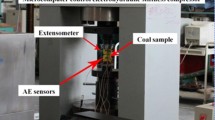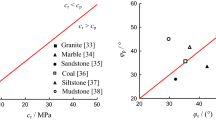Abstract
Based on the continuum damage mechanics, the damage variable of wave velocity is defined, and the piecewise curve damage evolution of rock material constitutive model is constructed. Using uniaxial compression experiments, using ultrasound on the wave velocity in the process of compression test, the relationship between strain and velocity is obtained, and then the experimental parameters of constitutive model were analyzed. Analysis shows that: All specimens had similar damage variable strain curve, which is roughly “S” type. The damage variable-strain constitutive model based on the change of wave velocity is divided into four stages, which are brittle damage zone, damage transition zone, damage extension zone, and fracture failure zone. At the peak value, the damage variable with the increase in strain amplitude increased sharply and the initial crack width increased significantly, and the crack extension is very unstable. Then the damage fracture evolution characteristics of the specimen during loading are obtained.












Similar content being viewed by others
References
Zhang, J.: Testing Study on Damage and Fracture Translation of Rock Material. Chongqing Jiaotong University, Chongqing (2015)
Zhao, C.; Wu, K.; Li, Sh; et al.: Energy characteristics and damage deformation of rock subjected to cyclic loading. Chin. J. Rock Mechan. Eng. 32(6), 1167–1175 (2013)
Mo, Y.; Zeng, Y.; Li, J.; et al.: Multiparameter constitutive model of rock damage under uniaxial loading. Chin. J. Undergr. Space Eng. 9(3), 477–481 (2013)
Dong, Ch; Zhao, G.: Constitutive model of rock damage based on energy dissipation and acoustic emission. Chin. J. Undergr. Space Eng. 11(5), 1116–1122 (2015)
Zhang, J.; Zhang, Y.; Li, X.: Study on damage constitutive model of rock considering progressive failure. Chin. J. Undergr. Space Eng. 11(6), 1528–1532 (2015)
Hu, F.: Based on the Theory of Fracture Mechanics and Damage Mechanism of fractured Rock Mass Damage is Studied. Chongqing University, Chongqing (2015)
Yan, D.: Study on the Damage Evolution Mechanism of Saturated Rock Mass Under Oil Immersed Condition. Chongqing University, Chongqing (2016)
Wen, T.; Tang, H.; Liu, Y.; et al.: Newly modified damage statistical constitutive model of rock based on impact factor. J. China Univ. Min. Technol. 45(1), 141–149 (2016)
Zhao, G.; Zhang, X.; Meng, X.; et al.: Elasto-brittle damage analysis of roadway surrounding rock based on continuous damage theory. Chin. J. Undergr. Space Eng. 12(2), 314–320 (2016)
Li, B.: Study on Fracture Damage Mechanism and Stability of Fractured Rock Mass. Chengdu University of Technology, Chengdu (2017)
Zhang, W.: Study on the Microscopic Mechanism of Rock Thermal Damage and the Evolution Characteristics of Macroscopic Physical and Mechanical Properties-Taking Typical Rock as an Example. China University of Mining and Technology, Xuzhou (2017)
He, A.; Wang, Z.; Bi, C.: Experimental study on thermal damage characteristics and mechanism of Huashan granite. Hydro Sci. Eng. 1, 95–101 (2018)
Liang, T.; Ge, H.; Guo, Zh; et al.: Evaluation of rock damage state with acoustic emission and velocity variation. Earthq. Res. China 28(2), 154–166 (2012)
Li, M.: Study on Dynamics Features of Ultrasonic Velocities in Loading Coal. Henan Polytechnic University, Jiaozuo (2015)
Xu, X.; Zhang, R.; Dai, F.; et al.: Effect of coal and rock characteristics on ultrasonic velocity. J. China Coal Soc. 40(4), 793–800 (2015)
Bu, J.: Study on the Variation of Ultrasonic Parameters of Red Sandstone with different Water Under Uniaxial Compression. China University of Mining and Technology, Xuzhou (2016)
Li, H.; Yang, Ch; Chen, F.; et al.: Development and application of an integrative testing device for acoustic waves and acoustic emission of rock. Rock Soil Mech. 37(1), 287–296 (2016)
Li, H.; Yang, Ch; Li, B.; et al.: Damage evolution and characteristics of ultrasonic velocity and acoustic emission for salt rock under triaxial multilevel loading test. Chin. J. Rock Mechan. Eng. 35(4), 682–691 (2016)
He, Y.: Research on ultrasonic velocity properties and damage development of sandstone under uniaxial compression. Chin. J. Undergr. Space Eng. 12(1), 44–48 (2016)
Yuan, P.: Study on Rock Failure Rate by Ultrasonic Vibration. Jilin University, Changchun (2017)
Wang, M.: Experimental study on monitoring internal damage of rock damage and identification of dangerous blocks by ultrasonic thickness gauge. Ind. Miner. Process. 10, 43–46 (2017)
Yin, S.; Zhao, D.; Zhou, Y.; et al.: Numerical simulation and experiment of the damage process of heterogeneous rock under ultrasonic vibration. J. Jilin Univ. (Earth Science Edition) 47(2), 526–533 (2017)
Wang, Z.; Liu, X.; Fu, Y.; et al.: Comprehensive screening method of “ultrasonic-rebound-density” for two kinds of rock specimens. Chin. J. Rock Mechan. Eng. 37(s1), 3575–3583 (2018)
Zhang, J.; Chen, H.; Wang, H.: Experimental study on the relationship between deformation and damage of rock like material and wave velocity. Yellow River 40(7), 104–107 (2018)
Zhao, M.; Xu, R.: The rock damage and strength study based on ultrasonic velocity. Chin. J. Geotech. Eng. 22(6), 720–722 (2000)
Kawamoto, T.: Deformation and fracturing behaviour of discontinuous rock mass damage mechanics theory. Int. J. Num. Anal. Methods in Geomech. 12(1), 1–30 (1988)
Liu, X.; Hao, J.: Continuum Damage Mechanics. National Defense Industry Press, Beijing (2011)
Komlos, K.; Popovics, S.; Nurnbergerova, T.; et al.: Ultrasonic pulse velocity test of concrete properties as specified in various standards. Cem. Concr. Compos. 18(5), 357–374 (1996)
Wang, H.; Song, Y.: Ultrasonic pulses behavior in various-size concrete specimens under compression. J. Dalian Univ. Technol. 47(1), 90–94 (2007)
Zhang, H.: Fracture and Damage Mechanics. Beihang University Press, Beijing (2016)
Qian, J.; Zhou, J.: Two concrete damage models and their application. J. Hohal Univ. 17(3), 40–47 (1989)
Acknowledgements
This study in the paper was funded by The National Natural Science Foundation of China (Nos. 11272185, 51678067 and 51378521), and Chongqing University Innovation Team (No. CXTDG201602012). The study was als financially supported by the Program (201309) for Par-Eu Scholars in Chongjing.
Author information
Authors and Affiliations
Corresponding author
Rights and permissions
About this article
Cite this article
Jinhao, Z., Hongkai, C., He, W. et al. Experimental Study on Damage Evolution Characteristics of Rock-Like Material. Arab J Sci Eng 44, 8503–8513 (2019). https://doi.org/10.1007/s13369-019-03864-0
Received:
Accepted:
Published:
Issue Date:
DOI: https://doi.org/10.1007/s13369-019-03864-0




